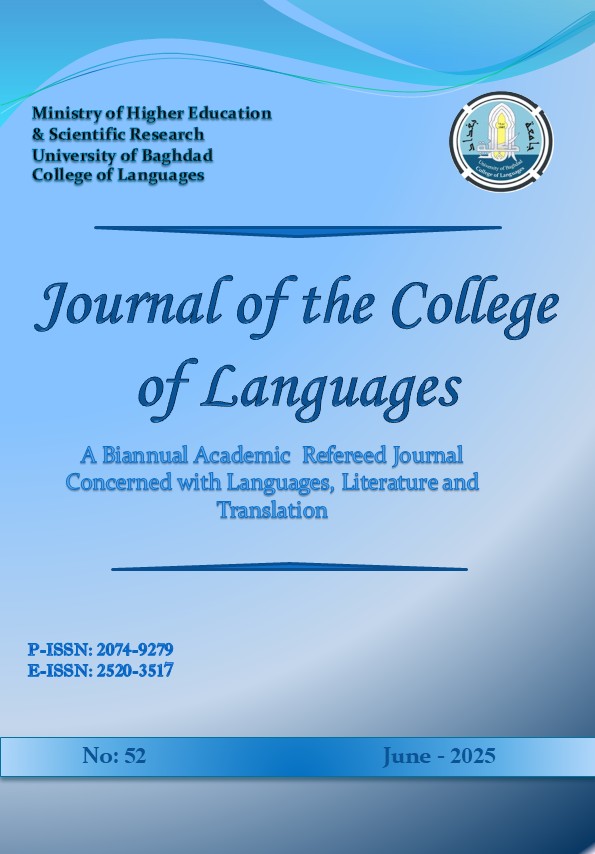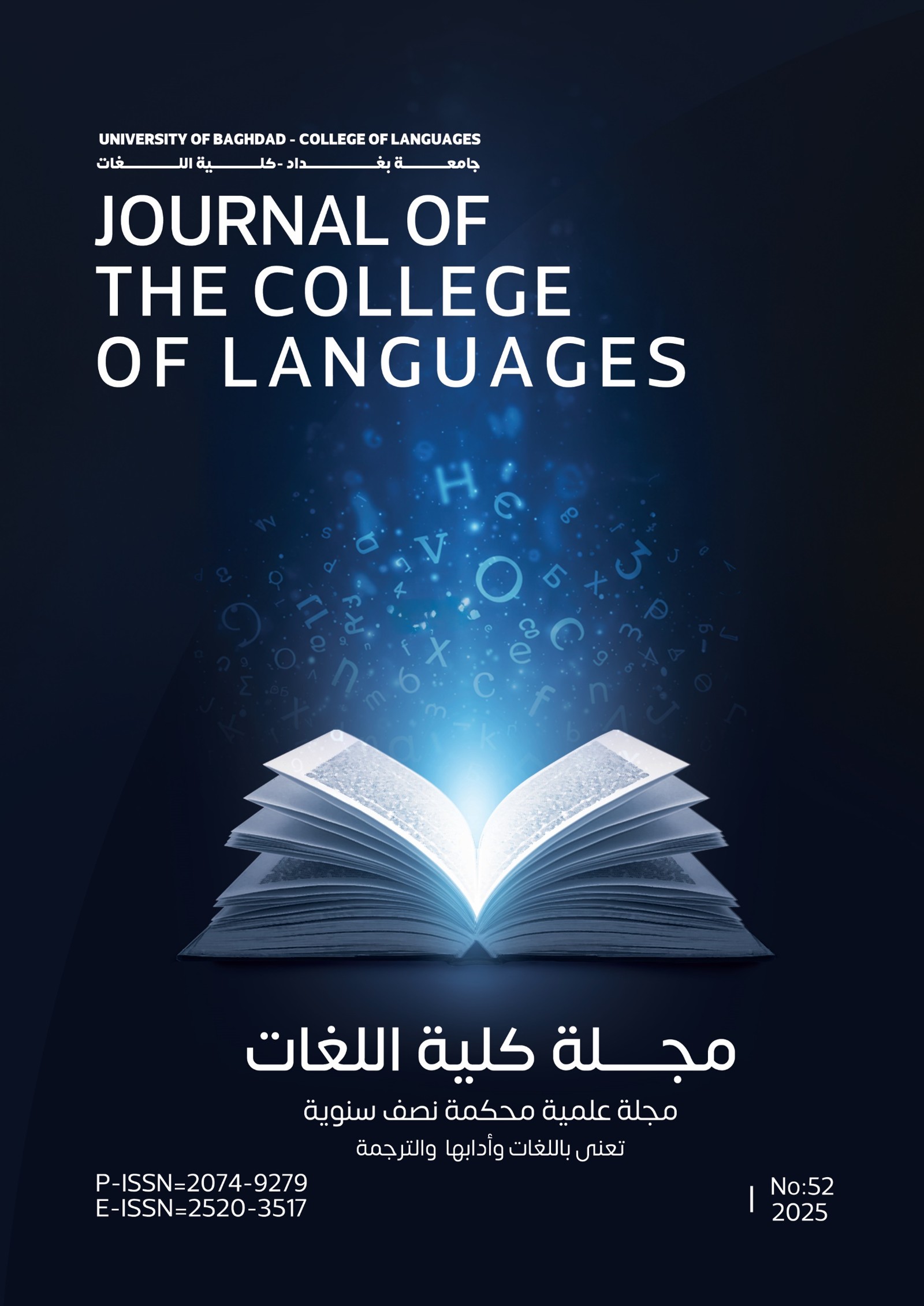A Stylistic Study of the Concept of Love in Kahlil Gibran’s ’The Prophet’
DOI:
https://doi.org/10.36586/jcl.2.2025.0.52.0001Keywords:
Gibran, The Prophet, Universal love, Stylistics, Lexical Items, Figures of SpeechAbstract
In his masterpiece ’The Prophet’, Kahlil Gibran presents his unwavering faith and passionate belief in the healing power of universal love that brings humans to sublime ideas and elevates their souls and behavior. The current study aims to find out the stylistic devices utilized to represent the concept of love based on the hypothesis that Gibran tends to use certain stylistic effects to convey his meaning. The study adopts Leech and Short’s (2007) framework of stylistic analysis to analyze the lexical items and figures of speech in selected extracts from the book. The findings reveal that Gibran prefers concrete nouns, dynamic verbs, and physical adjectives over abstract nouns, stative verbs, and psychological adjectives to show his energetic and realistic perspective on love. Finally, for figures of speech, Gibran mostly depends on personification referring to love as a person capable of doing actions (beckons to you, gathers you, etc.) besides simile and metaphor.
References
Acocella, J. (2007). Prophet Motive: The Kahlil Gibran Phenomenon. New York: The New Yorker.
Al-Fakhuri, H. (1986). Al-Jami’a fi Ta’areekh al-Adab al-Arabi: Al-Adab alHadeeth. Beirut: Dar Al-Jeel,
Al-Janabi, M. (2015). A Stylistic Analysis of Two Selected, English and Arabic, War
Poems. Journal of College of Languages.
Al-Khazraji, N. H. F. and Wong, B. E. (2013). Critical Reading to Gibran’s World in The Prophet. Arab World English Journal (AWEJ).
Al-Saidi, A. H. and Khalaf, A. S. (2022). Investigating the aesthetic effect in the Arabic translations of Gibran’s The Prophet. International Journal of Asia Pacific Studies
Amare, A. (2002). Some selected poems in English by Ethiopian poets: a stylistic analysis, Addis Ababa: AAU Libraries
Boushaba, S. (1988). An analytical study of some problems of literary translation: A study of two Arabic translations of K. Gibran’s The Prophet. Unpublished PhD diss., University of Salford, Manchester, England.
Brohi, F., Brohi, A. and Kabooro, N. (2021). An Analysis of Universality in Khalil Gibran’s The Prophet. Linguistics and Literature Review 7(1): 29- 42.
Buck, C. (2010). Kahlil Gibran. In American writers supplement. New York: Charles Scribners and Sons.
Burke, M. (2017). The Routledge handbook of stylistics, Routledge: London.
Carnie, A. (2013). Syntax: A generative introduction. Malden, MA: Blackwell Publishers
Gibran, K. (1923). The Prophet. New York: Knopf.
Hawi, K. (1972). Kahlil Gibran: His Background, Character and Works. Beirut: The Arab Institute for Research and Publishing.
Ibrahim, R. (2018). A Critical Stylistic Analysis of the Ideological Positioning in Some Selected Poems by John Donne. Journal of College of Languages.
Jabr, J. (1958). Gibran: Siratahu, Adabuh, Falsafatuh wa Rasmuh. Beirut: Dar al-Rashid lil-Tiba’ah wa al-Nashir.
Kane, T. S. 2000. The Oxford essential guide to writing. New York: Berkley Books.
Leech, G. and Short, M. (2007). Style in Fiction: A Linguistic Introduction to English Fictional Prose. (2nd ed.). London: Pearson
Mahmood, R. and Jamil, A. (2015). Stylistic Analysis of Holy Thursday by William Blake. International Journal of English Language and Linguistics Research
Marabout, M. O. (2010). Aesthetic effect in Arabic-English literary translation: A sample from Gibran Khalil Gibran. Unpublished MA thesis., Mentouri University of Constantine, Algeria
McArthur, T. (1992). Figurative Language. In: The Oxford Companion to the English Language (ed. T. McArthur) Oxford University Press.
Moleong, J. L. (2001). Metode Penelitian Kuantitatif. Bandung: PT Remaja Rosodakarya
Mugair, S. and Abbas, A. (2016). A Stylistic Analysis of Oscar Wilde’s the Nightingale and the Rose. International J. Soc. Sci. & Education
Najjar, Iskander. (2008). Qamus Gibran Khalil Gibran. Beirut: Dar AlSaqi
Niazi, N. (2013). A Stylistic Analysis of D.H. Lawrence’s ‘Sons and Lovers’. International Journal of Applied Linguistics & English Literature
Nuaimy, M. (2013). Gibran Khalil Gibran: The Prophet (trans.). Studied and analyzed
by Dr Nazik Saba Yard. Beirut: Dar al-Fikr.
Qrei, B. S. M. (2017). Dynamism in translating Khalil Gibran’s ‘The Prophet’. Unpublished MA thesis, Al-Quds University, Palestine.
Shaw, H. (1972). Dictionary of Literary Terms. McGrow-Hill.
Short, M. (1996). Exploring the Language of Poems, Plays and Prose. London: Addison. Wesley Longman Limited
Simpson, P. (2004). Stylistics: A Resource Book for Students. London: Routledge.
Verdonk, p. (2002). Stylistics. Oxford: Oxford University Press.
Wales, K. (2011). A dictionary of stylistics. (3rd ed.). London and New
York: Routledge
Widdowson, H. G. 1975. Stylistics and the teaching of literature. London: Routledge
Young, B. (1945). This Man from Lebanon. United States of America: The Ryerson Press.

Downloads
Published
Issue
Section
License
Copyright (c) 2025 Journal of the College of Languages (JCL)

This work is licensed under a Creative Commons Attribution 4.0 International License.







